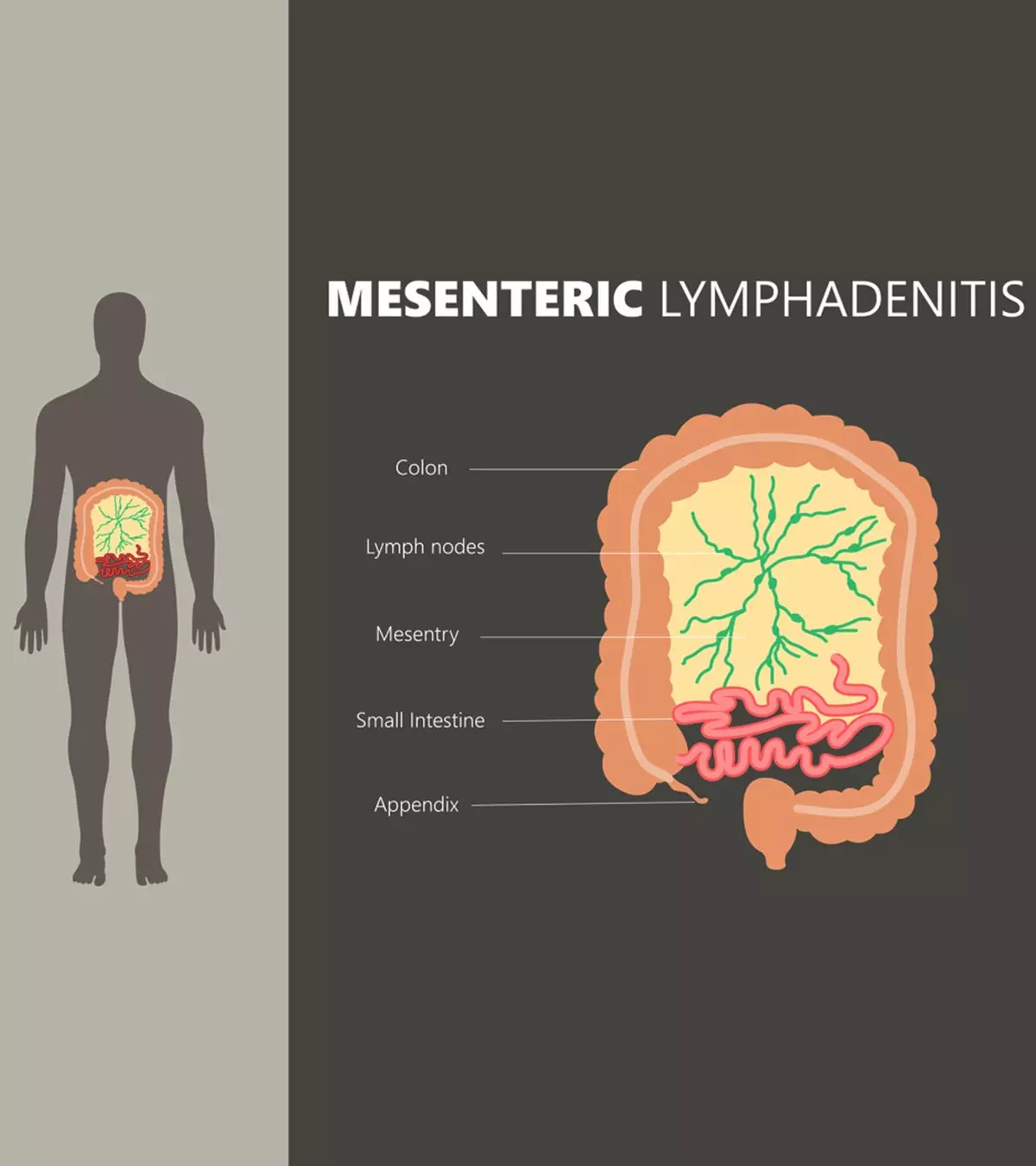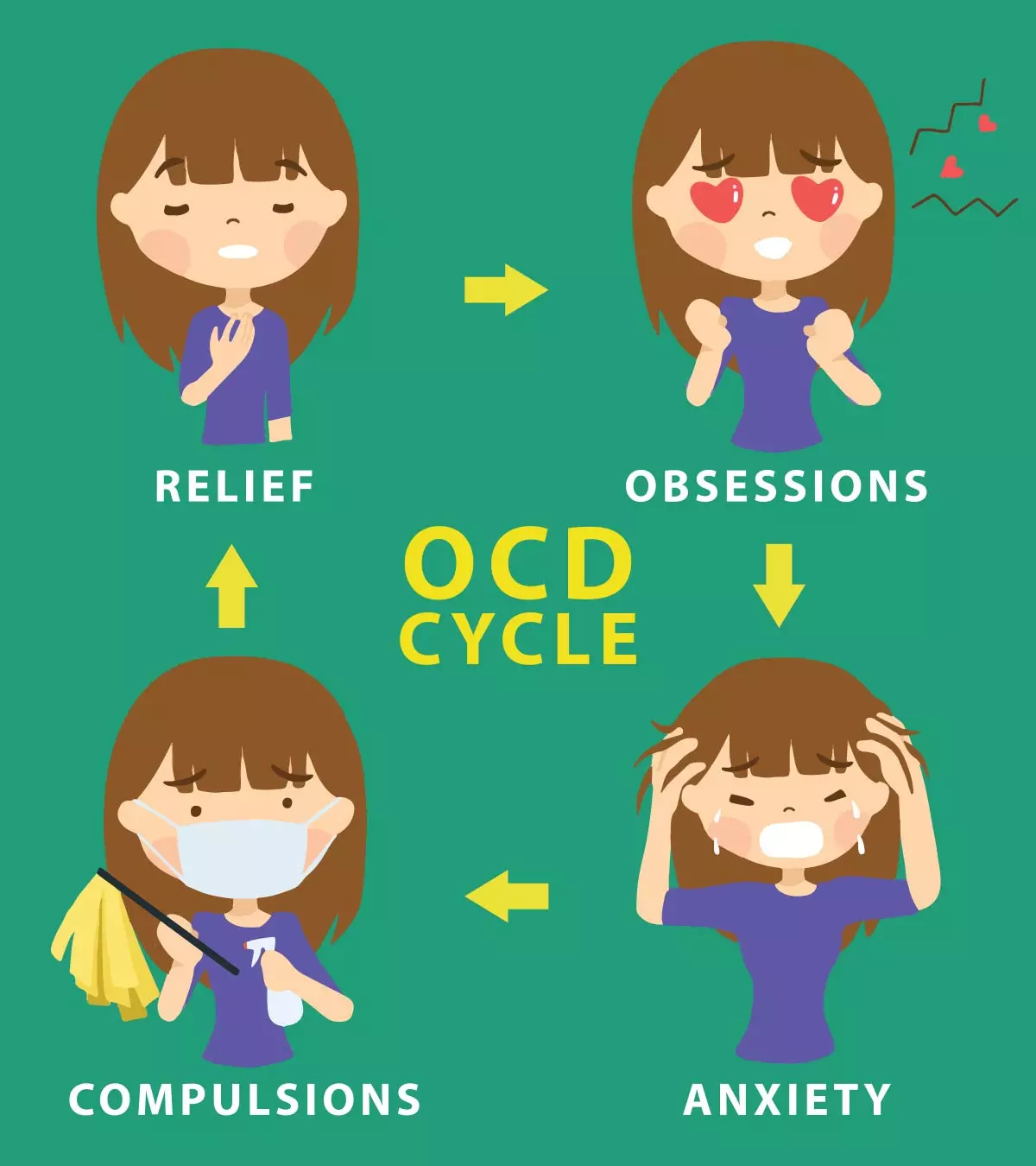
Image: iStock

Dyscalculia in children is characterized by math learning difficulties that can affect their ability to perform mathematical calculations and understand or learn arithmetic (1). Dyscalculia can be developmental (present at birth) or acquired (occurring later in life, such as after a brain injury).
Children with dyscalculia may face several challenges on the academic and personal front because they may have significantly lower academic skills than their peers (2) (3). It may lead to issues with self-confidence and self-esteem.
Read this post to learn about the causes, symptoms, diagnosis, and treatment options for children with dyscalculia.
Key Pointers
- Dyscalculia can be due to genetic reasons, brain damage, or developmental or environmental issues in children.
- Failure to memorize simple numbers, issues with simple calculations, trouble identifying patterns, and inability to identify mathematical symbols are signs of dyscalculia in children.
- Dyscalculia and associated learning problems should be diagnosed and managed with special attention and learning programs.
Causes Of Dyscalculia In Children
In the Diagnostic and Statistical Manual of Mental Disorders, 5th Edition (DSM-V), as stated by the American Psychiatric Association, dyscalculia is referred to difficulties with basic mathematical concepts, numeracy, facts, and calculations (2)
. Some children with dyscalculia cannot grasp basic number concepts and work hard to memorize them, but they miss the logic behind them.
According to UNESCO, the exact causes for dyscalculia are unknown and vary from child to child. However, some potential risk factors of dyscalculia in children are (4) (5)
- Genetics: Studies have found that a child with dyscalculia is more likely to have a parent or sibling with the same mathematical issue. Some genetic disorders that have been observed in patients with dyscalculia include Turner’s syndrome, Velocardiofacial syndromeiA genetic condition leading to cleft palate, heart defects, problems fighting infections, and decreased calcium levels. , Fragile X syndrome, and Williams’s syndrome.
- Brain development: Brain imaging studies have shown some differences between people with and without dyscalculia. Brain impairment in certain areas (i.e., specific parts of the parietal lobeiOne of the four brain lobes; responsible for spatial awareness, body awareness, and sensory perception. ), responsible for processing numerical information due to various genetic and developmental disorders (such as Turner’s syndromeiA genetic disorder affecting females, characterized by short stature and early loss of ovarian function. ), can also cause developmental dyscalculia in children.
- Environmental factors: Certain environmental factors have been linked to dyscalculia in children, including maternal alcohol consumption (fetal alcohol syndrome), premature birth, and low birth weight, as these conditions may induce brain developmental delay in children.
- Brain injury: Sometimes, a child may also develop a condition called ‘acquired dyscalculia’ due to an injury to certain parts of the brain.
- External factors: Poor teaching, low socioeconomic status, and behavioral attention problems or domain-general cognitive deficits may also cause secondary developmental dyscalculia in children (6).
Symptoms Of Dyscalculia In Children
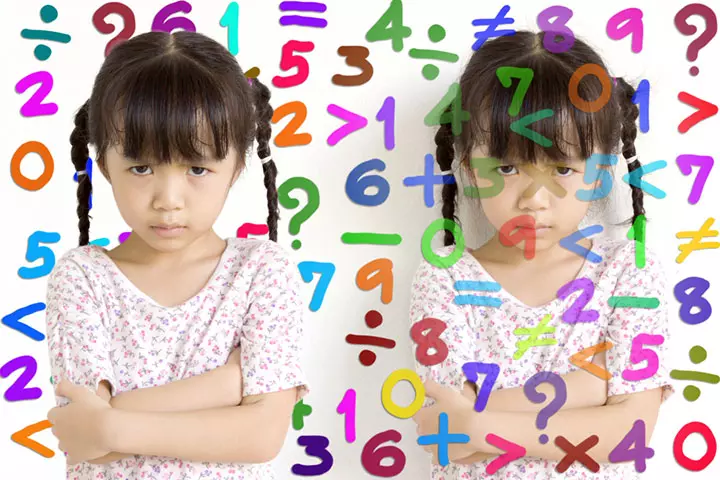
Image: Shutterstock
The signs and symptoms of dyscalculia in children may vary from person to person and age.
In preschool children (1) (3):
- Delayed learning to count
- Cannot memorize simple numbers
- Struggle to relate mathematical symbols (5) to their corresponding words (five)
- Have trouble identifying patterns and arranging things in order
- Relies on visual aids, such as counting with fingers, long after others have stopped using this method
In primary school children (1) (3):
- Have trouble remembering and learning basic math functions and equations, such as addition and subtraction, time tables, and other topics
- Counting with fingers instead of using advanced skills (such as mental math)
- Mathematical signs and symbols are not well understood
- Struggle with math homework assignments and tests
- Have difficulty keeping at grade-level in math
- Have difficulty keeping track of game scores and memorizing digits, such as phone numbers and zip codes
- Unable to tell time on an analog clock
- Have trouble anticipating how much something will cost or how long a task will take
- Avoid circumstances that demand understanding numbers, such as playing math games
- Struggles to remember directions and to tell right from left
In secondary school children (1):
- Struggles with visual-spatial concepts, such as graphs and charts
- Have difficulty figuring various ways to solve the same mathematical problem, such as adding the length and breadth of a rectangle and doubling the result to find the perimeter
- Struggles with reasoning methods and multi-step mathematical approaches
- Have difficulty assessing speed, distance, and directions, as well as measuring goods, such as ingredients
- Have difficulty with money matters
- Avoid answering math-related questions during everyday interactions
 Be watchful
Be watchfulProblems Associated With Dyscalculia In Children
The US National Center for Education Statistics (NCES) states that of the 7.3 million students aged 3–21 who received special education and associated services, approximately 32 percent were identified as having specific learning disabilities, including dyscalculia. Dyscalculia often coexists with other disabilities, including (4) (7):
- Dyslexia: Studies show that about 43–65% of children with dyscalculia (math disabilities) are often diagnosed with dyslexia (learning disability).
- Attention deficit hyperactivity disorder (ADHD): Most children with dyscalculia are also diagnosed with ADHD. However, these children may have the inability to process numeric language as a characteristic of ADHD. Therefore, once ADHD symptoms are under control, it is advised to reassess a child’s mathematical skills.
- Math anxiety: Some children may have both math anxiety and dyscalculia. Unlike dyscalculia, math anxiety is a feeling pressured to perform well, leading to poor math skills.
- Genetic disorders: Genetic disorders, including Turner’s syndrome, fragile X syndrome, and Gerstmann’s syndrome, have also been associated with dyscalculia in children.
- Mental illness: About 30-35% of children with learning disabilities have been found to have a mental illness.
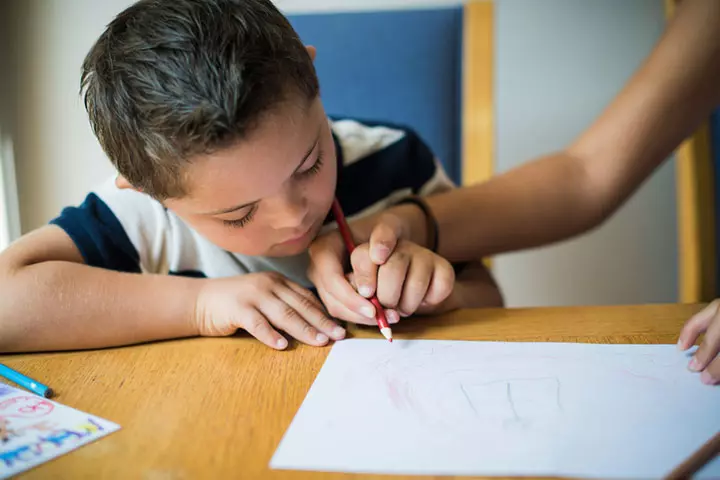
Image: Shutterstock
- Accompanying social and emotional problems: Children with dyscalculia frequently experience severe emotional distress due to low academic performance; this can lead to a negative mindset toward mathematical assignments and can develop math anxiety and school phobia.
- Cognitive deficits: Brain impairment in children with dyscalculia can lead to a pattern of degeneration in cognition, which typically presents as skills impairments, such as lack of focus, impaired working memory, inability to multitask, delayed language development, and slow visual-spatial processing.
- Psychosomatic complaints: Sometimes, a child with dyscalculia may also complain of abdominal pain or headache when a math test is scheduled, or math homework is due.
 Point to consider
Point to considerDiagnosis Of Dyscalculia In Children
There is no specific test for diagnosing dyscalculia in children, and it is based on the child’s struggle in learning mathematics. If you suspect your child to have dyscalculia, consult with your child’s teachers, medical professionals, or psychologists to evaluate your child. They can help identify dyscalculia and its severity through specific tests and observations.
In general, the diagnosis of dyscalculia in children mainly include (5):
- Identifying difficulty in mathematics that affects academic or everyday life,
- Ruling out the other factors, such as ADHD, anxiety disorders, and other mental illnesses, that could be responsible for the difficulty
A professional or a medical specialist will conduct a detailed examination for the diagnosis of dyscalculia in children, which can include (8):
- Clinical examination: It consists of a standardized intelligence test and a physical examination, including a neurological examination and visual and hearing testing to rule out these impairments and other problems that can hinder mathematical ability.
- Detailed history: A thorough history, including personal, familial, and scholastic developmental history, can help evaluate the underlying cause of dyscalculia in children.
- Psychological assessment: It considers comorbid mental diseases, psychosocial stress factors, and low family socioeconomic levels. The assessment may include the systemic documentation of the impact of performance deficiencies on mental and social development, school integration, and social involvement (psychosocial integration).
- Psychometric testing: Several psychometric tests of mathematical performance are available to evaluate the methodological quality (basic arithmetic operations, numerical and quantitative processing, word problems, etc.) to perform mathematical tasks. Some of the most recommended tests are:
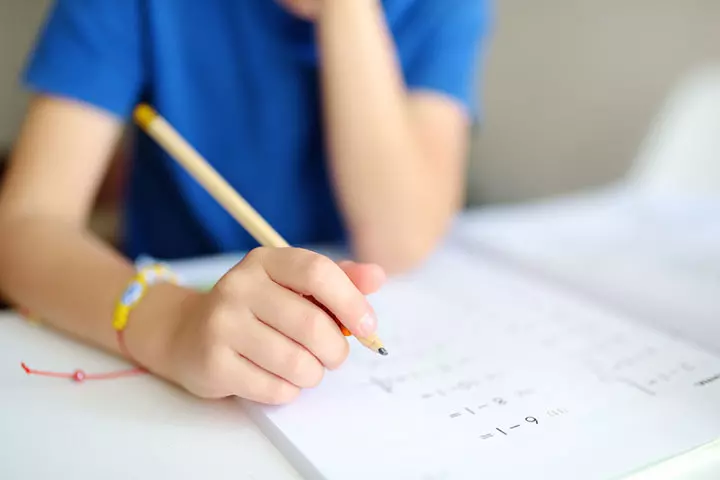
Image: Shutterstock
- CODY math test
- Test of basic mathematical competencies at the beginning of schooling (MBK 1+)
- Bamberg Dyscalculia Diagnostic Test (BADYS) 1–4+ (R)
- DEMAT German mathematics test
- Eggenberg Calculation Test (ERT)
- Heidelberg Arithmetic Test (HRT) 1-4
- Bielefeld Arithmetic Test (BIRTE)
- Test of numerical calculating skills from kindergarten to the third grade (TEDI-MATH)
- Competence Assessment in Kindergarten and School (KEKS)
- Diagnostic Inventory for Arithmetic Skills in Primary School (DIRG)
- Mathematical and Arithmetical Concepts in First-Graders—Diagnosis (MARKO-D1+)
Treatment For Dyscalculia In Children
The treatment for children with dyscalculia is difficult. It depends on a child’s cognitive functional profile and severity of signs and symptoms (7).
- Specialized personnel, including learning specialists, educational psychologists, or neuropsychologistsiHealthcare professionals who specialize in evaluating and treating behavioral and cognitive changes. , will devise a treatment plan for children with dyscalculia (8).
- The methods include specially designed teaching plans and educational support (Dortmund number concept training, Dybuster CalcularisiA web-based mathematical educational tool that enables learning in children with dyscalculia. , etc.) (8), arithmetic learning games, categorization of subject matter, use of indicators in strategy-learning, small, interactive groups, and repeated practicing of mathematics tasks, especially for multi-digit calculations (7).

Image: IStock
- Preschool-aged children with dyscalculia should start receiving supportive treatment at the earliest to positively impact subsequent mathematical competence and academic performance (8).
- If significant psychopathological signs, such as anxiety, depression, or ADHD, are present, the treatment may also include intervention strategies, such as drugs and psychotherapy (7).
- Treatment should be continued as long as the interdisciplinary team caring for the child (such as therapist, teacher, and physician) considers it is appropriate and necessary (8).
- Support your child’s learning at home, ensure they follow the suggested teaching plans, and provide a conducive learning environment to manage the condition.
Strategies To Help A Child With Dyscalculia
Given below are some methods which you can try to help your child with dyscalculia:
- Support academically: Children with dyscalculia require additional support when performing mathematical tasks, doing homework, and taking tests. Using a calculator, extra courses, alarms, phone reminders to keep track of time, teacher’s notes, and other helpful tools and accommodations can assist you and your child in completing these tasks (9).
- Address anxiety: Most children with dyscalculia often feel distressed and have serious anxiety when performing mathematical tasks, known as “math anxiety.” According to Dr. Meredyth Kravitz, a clinical neuropsychologist, “One of the keys to helping kids with dyscalculia is teaching them anxiety management strategies.” Sports, including football, reading books, playing board games, and other activities (cooking and baking) could help and is a fun way to deal with math anxiety at home (10).

Image: Shutterstock
- Support self-esteem: Dyscalculia can significantly influence daily activities and lead to self-consciousness and avoidance in children. Supporting them academically and emotionally can help them gain self-confidence and gain a better understanding of their disease. Some methods may include acknowledging and appreciating their efforts, assisting them in identifying their abilities, etc (9).
- Working with school: Teachers are an excellent source of information and can also assist in dealing with a child with dyscalculia. You can ask your child’s teacher if there are any classroom strategies which you may use at home (10).
Frequently Asked Questions
1. Do kids grow out of dyscalculia?
In most cases, children will not overcome dyscalculia. However, they may outgrow dyscalculia involving challenges in learning strategies and sequences. Therefore, it is better to seek professional help and support your child with dyscalculia (11).
2. Does dyscalculia affect the intelligence of a child?
No, children with dyscalculia may be struggling with mathematics but can be otherwise intelligent. They may perform well in other subjects at school (12).
3. Do children with dyscalculia have trouble reading?
No, kids with dyscalculia usually have issues with mathematics but may not have problems with reading and spelling. However, they may have difficulty reading maps and following directions (13).
4. What is the difference between dyscalculia and dysgraphia?
While dyscalculia refers to the inability of a child to learn mathematics and arithmetic, dysgraphia is a condition that manifests in children as impaired handwriting, impaired spelling or a combination of both (14).
Dyscalculia in children is characterized by trouble understanding numbers and math concepts. They may work hard and memorize math problems but fail to understand their logic and fundamentals. Children may face difficulty competing with their peers in academics and other competitive exams. Special and personalized attention at school and home can help children cope with their math learning disabilities. Your doctor may evaluate the child to know if there are other co-existing disabilities with dyscalculia.
Infographic: Dyscalculia Signs And Symptoms In Children Of Different Age Groups
Depending on the child’s age, dyscalculia may manifest in various ways and exhibit different symptoms. Therefore, it is crucial to be aware of the signs and symptoms to assist in identifying dyscalculia in children of different age groups and provide effective early intervention. Look at the infographic below for various symptoms of dyscalculia in children.
Some thing wrong with infographic shortcode. please verify shortcode syntaxIllustration: Dyscalculia in Children: Causes Symptoms And Treatment
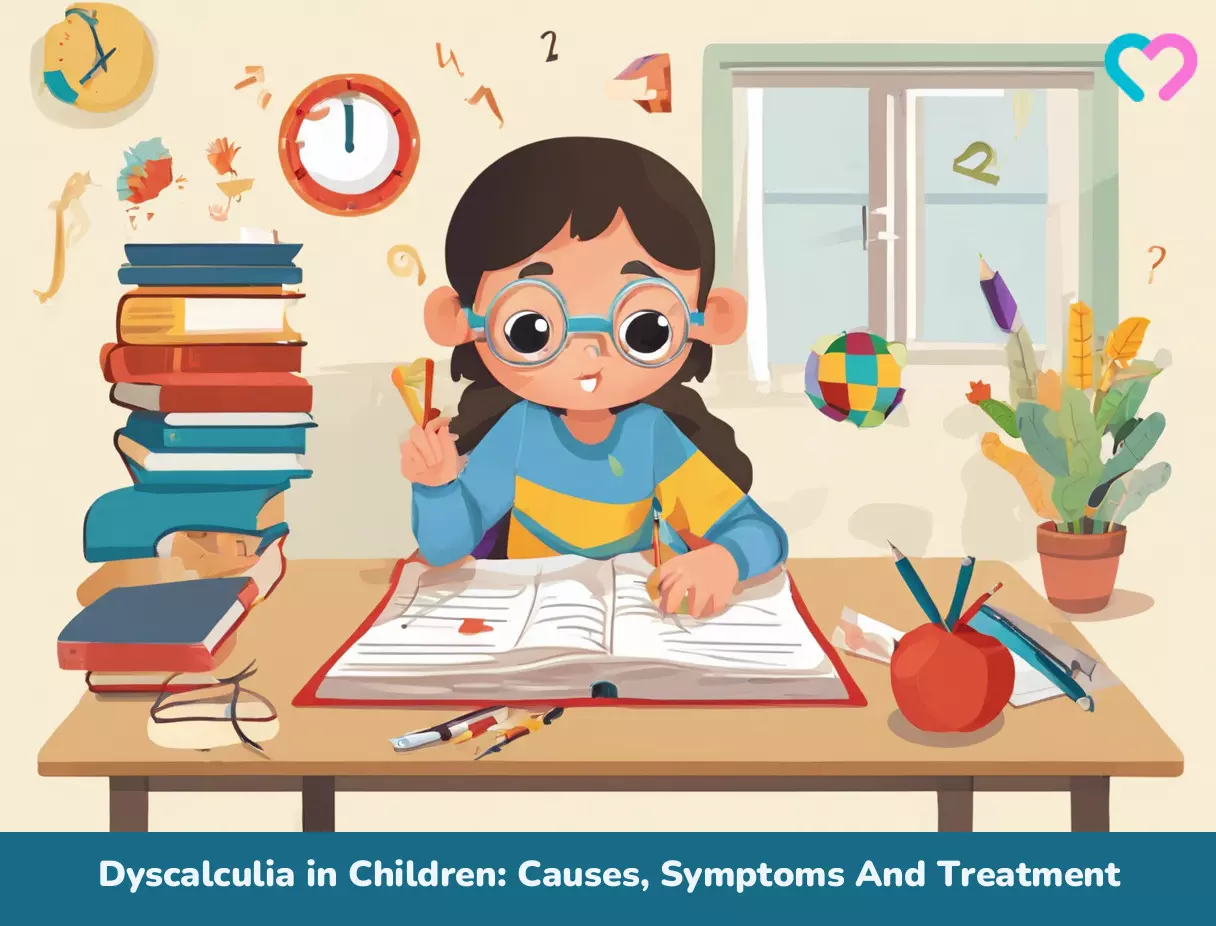
Image: Stable Diffusion/MomJunction Design Team
Dyscalculia is a learning disability that affects mathematical skills in children. Learn about its symptoms, diagnosis, and treatments in this video.
References
- How to Spot Dyscalculia.
https://childmind.org/article/how-to-spot-dyscalculia/ - Cárdenas SY Silva-Pereyra J et al. Arithmetic processing in children with dyscalculia: an event-related potential study.
https://www.ncbi.nlm.nih.gov/pmc/articles/PMC7847199/ - Kessler E. Dyscalculia: An Overview.
https://www.smartkidswithld.org/first-steps/what-are-learning-disabilities/dyscalculia-an-overview/ - About Dyscalculia.
https://mgiep.unesco.org/article/about-dyscalculia - Wilson AJ. Dyscalculia Primer and Resource Guide.
https://www.oecd.org/education/ceri/dyscalculiaprimerandresourceguide.htm - Price GR Ansari D. Dyscalculia: Characteristics Causes and Treatments.
https://digitalcommons.usf.edu/cgi/viewcontent.cgi?article=1112&context=numeracy - Kaufmann L von Aster M. The diagnosis and management of dyscalculia.
https://www.ncbi.nlm.nih.gov/pmc/articles/PMC3514770/ - Haberstroh S Schulte-Körne G. The Diagnosis and Treatment of Dyscalculia.
https://www.ncbi.nlm.nih.gov/pmc/articles/PMC6440373/ - Jacobson R. How to Help Kids With Dyscalculia.
https://childmind.org/article/how-to-help-kids-dyscalculia/ - How to help your child with math.
https://www.understood.org/en/articles/en/how-to-help-your-child-with-math - Dyscalculia Primer and Resource Guide.
https://www.oecd.org/education/ceri/dyscalculiaprimerandresourceguide.htm - About Dyscalculia.
https://mgiep.unesco.org/article/about-dyscalculia - Living with Dyscalculia.
https://mgiep.unesco.org/article/living-with-dyscalculia - Understanding Dysgraphia.
https://dyslexiaida.org/understanding-dysgraphia/ - Dyscalculia : What it causes and treatment.
https://my.clevelandclinic.org/health/diseases/23949-dyscalculia#symptoms-and-causes
Community Experiences
Join the conversation and become a part of our nurturing community! Share your stories, experiences, and insights to connect with fellow parents.
Read full bio of Dr. Arva M Bhavnagarwala
Read full bio of Reshmi Das
Read full bio of Dr. Ritika Shah
Read full bio of Apoorva K












